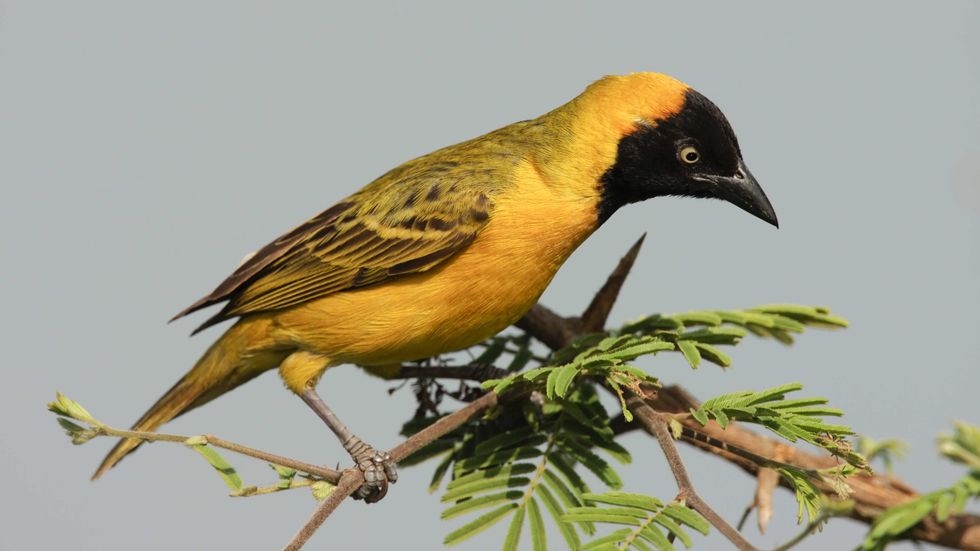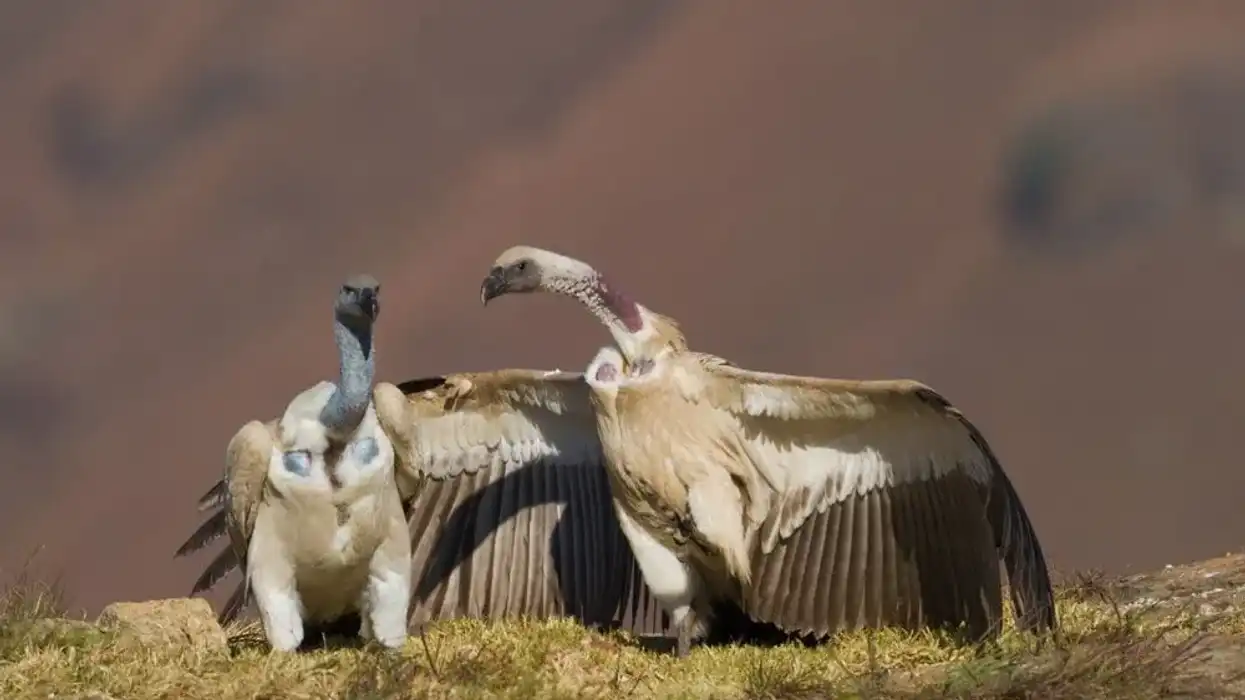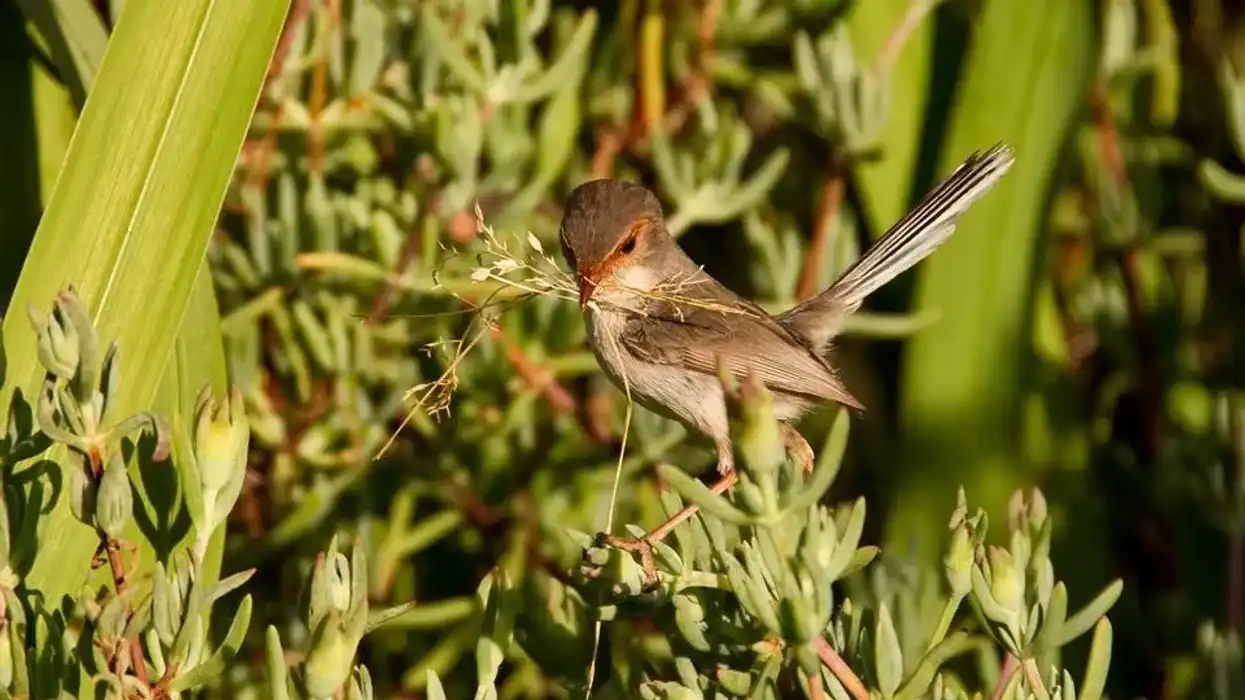In this article, we shall be opening the book of ornithology and going to discuss about a small bird whose distribution range is across the east, south east and south provinces of Africa. That small bird is called the lesser masked weaver (Ploceus intermedius).
Lesser masked weavers are Passeriformes birds in the family Ploceidae. They are mostly yellow colored with a pitch black face, neck and crown.
Actually this color pattern is developed by the male birds during the breeding season. They have a yellow-black upper body and a pure yellow lower body with a pitch black colored beak.
Male species during the non breeding season and female species wear the same plumage which is olive yellow colored neck and head portion, yellow-green upper body and a whitish lower body.
The beak color also changes from black to sort of grayish. They have two breeding seasons, one from September to October and another from January to February.
They are polygynous species and males construct their nests. The nests are made up of grass, leaves and reeds with a narrow entrance.
This was just a small introduction of this species. There are more interesting and funny information about this bird waiting for you in the upcomming sections. So keep reading!
For more relatable content, check out these orb weaver facts and garden orb weaver facts for kids.
Lesser Masked Weaver Interesting Facts
What type of animal is a lesser masked weaver?
Lesser masked weaver (Ploceus intermedius) is a type of bird. They are found in south-eastern, eastern and south Africa.
What class of animal does a lesser masked weaver belong to?
The lesser masked weaver belongs to the class Aves. They are small birds who belong to the order Passeriformes, family Ploceidae and genus Ploceus. The scientific name of these species is Ploceus intermedius.
How many lesser masked weavers are there in the world?
Lesser masked weaver (Ploceus intermedius) birds are species of Least Concern. They are found across east, south-east and south African land in adequate numbers. So counting their population is a bit tough.
Where does a lesser masked weaver live?
Lesser masked weaver are Passeriformes birds who live in the Savanna forests. They can be found in the woodlands near rivers or streams and forest edges.
What is a lesser masked weaver's habitat?
Lesser masked weaver (Ploceus intermedius) species are distributed across the sub Saharan African lands. They are commonly seen across the east, south east and south Africa.
Who do lesser masked weaver live with?
Lesser masked weaver (Ploceus intermedius) birds are colonial in nature. They nest in colonies for proper guidance and security.
How long does a lesser masked weaver live?
There are no valid information available on how long they live but it is vaguely estimated that lesser masked weaver birds live up to the age of 9-10 years.
How do they reproduce?
Lesser masked weaver (Ploceus intermedius) birds have two breeding season in a year. Their breeding happens from September to October and again from January to February.
Masked weaver birds are polygynous in nature, which means the male birds mate with two or more female birds. Their breeding happens in colonies and a single colony can have 10-300 breeding male birds. Male weavers have a fixed breeding range where they make relation with 3-4 breeding female weavers.
Male weavers build the nests on thin branches and sometimes on water to protect it from predators. The nests are made of grass, leaves and reeds mainly with a narrow entrance.
The masked weaver male attracts the female birds and after their affirmative reaction, breeding begins. After breeding, the female bird lays two to four eggs which she incubates for around 13 days. Both the adult birds feed their chicks until they become a little big.
Cuckoos tend to invade their nests for laying eggs. Masked weavers are one of the smallest birds that act as hosts to brood parasite eggs.
What is their conservation status?
According to IUCN red list, lesser masked weaver (Ploceus intermedius) bird species are considered under the conservation status of Least Concern. They inhabit east, south east and southern Africa in adequate numbers.
Lesser Masked Weaver Fun Facts
What do lesser masked weaver look like?
Lesser masked weaver are small bird species in the family Ploceidae. They have vibrant and contrasting feather colors, which is very attractive. Male and female weavers have different visible feather colors.
And the male itself has two different feather colors depending on what season it is. Around the breeding season, males grow a dark and vibrant plumage. Their covered in mostly black-yellow feathers with a black beak.
The face area from upper neck to the crown becomes pure black in color. The upper body and wings have black-yellow feathers while the lower body stays yellow colored.
Males during non-breeding season display a set of subtle, pale colors. Then the crown area becomes olive colored with yellow neck and face. The body plumage becomes gray-yellow.
They have small legs and a pale-white eyes. The plumage in females is similar to the non breeding males. They are small birds with an average body length range of 6-7 in (15-17cm) with a body weigh of around 0.6-0.9 oz (17–27 g).

How cute are they?
They are small bird species from the family Ploceidae. They have a sparrow like appearance and seem very cute and adorable.
How do they communicate?
These bird species usually communicate through small tweets and can be seen flying freely in their habitat. While protecting their nests, male birds can show a high temper through harsh chattering noise.
How big is a lesser masked weaver?
Lesser masked weaver have widespread distribution range across the African continent. They are agile small birds who grow to a length range of 6-7 in (15-17cm) and have a weigh range of 0.6-0.9 oz (17–27 g).
How fast can a lesser masked weaver fly?
Lesser masked weaver species are small and agile birds commonly seen flying from trees to trees in their habitats. But unfortunately there are records of their exact flying speed.
How much does a lesser masked weaver weigh?
Lesser masked weaver bird species grow to a length of 6-7 in (15-17cm) and have weigh around 0.6-0.9 oz (17–27 g).
What are the male and female names of the species?
There are no specific names assigned for the males and females of this species. Male species become more vibrant looking during the breeding season while the female species wear a pale plumage.
What would you call a baby lesser masked weaver?
Like all other baby bird species, baby lesser masked weaver are also known as chicks and young ones.
What do they eat?
Masked weavers primarily follow an omnivorous diet and mainly feed on insects, seeds and nectar. Some of their favorite insects are caterpillars and grasshoppers. Lesser masked weavers are eaten by hawks and ravens.
Are they dangerous?
These bird species can be a little aggressive while defending their nests but cause no harm to humans. They eat insects and seeds mainly.
Would they make a good pet?
Not really, weavers are particularly wild birds who do not do well in captivity. It's far better to watch them in the wild than capturing them.
Did you know...
Lesser masked weavers are not migratory birds. They inhabit the east, south and south east region of Africa the whole year. This makes them an endemic species of the region.
How to spot lesser masked weaver?
Lesser masked weavers can be spotted in their natural habitat who are endemic to the east, south east and south parts of African continent. During their breeding season, male species are seen to have vibrant yellow-black plumage. Females stay normally olive green-yellow colored for the whole year. They have a pitch black to gray beaks depending on the season.
How many eggs do lesser masked weaver lay
After breeding, females lay two to four eggs which they incubate for around 13 days.
Here at Kidadl, we have carefully created lots of interesting family-friendly animal facts for everyone to discover! For more relatable content, check out these little spotted kiwi facts and indigo macaw facts pages.
You can even occupy yourself at home by coloring in one of our free printable lesser masked weaver coloring pages.









